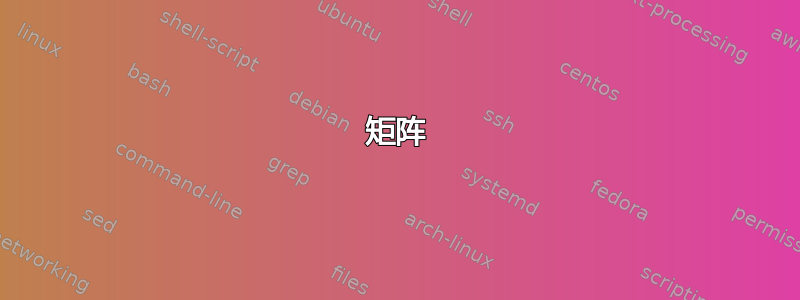
我正在尝试重现下图:

我想知道我应该用什么来生成这个。我可以制作矩阵,这很简单,但让箭头正确才是困难的……使用起来会很有趣这个例子,其中 S_{ij} 是带圆圈的节点,然后有些节点没有连接,而椭圆和 S_i: 是节点,但它们不会被圈起来。我正在寻找这里,我认为这也会起作用,但我还不知道如何解释(mij)符号,或者如何将箭头连接到节点。
到目前为止,我得到以下内容:

\documentclass{article}
\usepackage{tikz}
\usetikzlibrary{arrows}
\begin{document}
\begin{tikzpicture}[->,>=stealth',shorten >=1pt,auto,node distance=3cm,
thick,main node/.style={circle,fill=blue!20,draw,font=\sffamily\Large\bfseries}]
\node[main node] (1) {$S_{11}$};
\node[main node] (2) [right of=1] {$S_{12}$};
\node[main node] (3) [below of=1] {$S_{21}$};
\node[main node] (4) [below of=3] {$S_{31}$};
\node[main node] (5) [below of=2] {$S_{22}$};
\node[main node] (6) [right of=2] {$S_{13}$};
\node[main node] (7) [right of=6] {$S_{14}$};
\node[main node] (8) [below of=6] {$S_{23}$};
\node[main node] (9) [below of=5] {$S_{32}$};
\node[main node] (10) [below of=4] {$S_{41}$};
\node[main node] (11) [right of=10] {$S_{42}$};
\node[main node] (12) [right of=11] {$S_{43}$};
\node[main node] (13) [right of=12] {$S_{44}$};
\node[main node] (14) [right of=9] {$S_{33}$};
\node[main node] (15) [right of=14] {$S_{34}$};
\node[main node] (16) [right of=8] {$S_{24}$};
\path[every node/.style={font=\sffamily\small}]
(1) edge node [right] {} (2)
(2) edge node [right] {} (3)
(3) edge node [right] {} (4)
(4) edge node [right] {} (5)
(5) edge node [right] {} (6)
(6) edge node [right] {} (7)
(7) edge node [right] {} (8)
(8) edge node [right] {} (9)
(9) edge node [right] {} (10);
\end{tikzpicture}
\end{document}
答案1
正如 Qrrbrbirlbel 所评论的,您可以使用该\matrix命令。库matrix of math nodes中的选项matrix将通过在每个单元格中自动打开数学模式来节省您的一些输入。当您命名矩阵时(m),您可以使用语法来引用该矩阵的行和列(m-i-j)中的单元格。要连接节点,只需在设置矩阵后绘制边缘即可。ij
\documentclass{article}
\usepackage{tikz}
\usetikzlibrary{matrix}
\begin{document}
\begin{tikzpicture}
\matrix(m)[matrix of math nodes,column sep=1cm,row sep=1cm]{
s_{11} & s_{12} & s_{13} & s_{14} & \cdots \\
s_{21} & s_{22} & s_{23} & s_{24} & \cdots \\
s_{31} & s_{32} & s_{33} & s_{34} & \cdots \\
s_{41} & s_{42} & s_{43} & \cdots \\
};
\draw[->]
(m-1-1)edge(m-1-2)
(m-1-2)edge(m-2-1)
(m-2-1)edge(m-3-1)
(m-3-1)edge(m-2-2)
(m-2-2)edge(m-1-3)
(m-1-3)edge(m-1-4)
(m-1-4)edge(m-2-3)
(m-2-3)edge(m-3-2)
(m-3-2)edge(m-4-1);
\end{tikzpicture}
\end{document}

答案2
这是一个自动绘制边缘的解决方案;无需逐一指定它们!
您可以根据需要将图表放大:只需通过更改正整数的值来指定所需的节点数\N。
注意:如果未能babel使用该english选项加载包,则会产生错误。请参阅tikz-uml 序列图“Extra \or”错误更多细节。
编辑: 也可以看看Qrrbrbirlbel 的“链条”解决方案,精神上和我的很相似。


\documentclass{article}
\usepackage[english]{babel}
\usepackage{etoolbox}
\usepackage{pgfplots}
\usetikzlibrary{arrows}
\begin{document}
\begin{tikzpicture}%
[
->,
>=stealth',
scale=2,
auto,
thick,
main node/.style=%
{
% circle,
% fill=blue!20,
% draw,
font=\sffamily\Large\bfseries,
}
]
\pgfmathtruncatemacro\N{10}
\pgfmathtruncatemacro\i{1}
\pgfmathtruncatemacro\j{1}
\node[main node] at (\j,-\i) (n1) {$S_{\i\j}$};
\pgfplotsforeachungrouped \current in {1,2,...,\N-1}%
{
\pgfmathtruncatemacro\next{\current+1}
\ifnum\i=1% (first row)
\ifnumodd{\j}%
{ % Go East
\pgfmathtruncatemacro\j{\j+1}
}{% Go South West
\pgfmathtruncatemacro\i{\i+1}
\pgfmathtruncatemacro\j{\j-1}
}
\else%
\ifnum\j=1% (first column)
\ifnumodd{\i}%
{ % Go North East
\pgfmathtruncatemacro\i{\i-1}
\pgfmathtruncatemacro\j{\j+1}
}{% Go South
\pgfmathtruncatemacro\i{\i+1}
}
\else
\pgfmathtruncatemacro{\ijsum}{\i+\j}
\ifnumodd{\ijsum}%
{ % Go South West
\pgfmathtruncatemacro\i{\i+1}
\pgfmathtruncatemacro\j{\j-1}
}{% Go North East
\pgfmathtruncatemacro\i{\i-1}
\pgfmathtruncatemacro\j{\j+1}
}
\fi
\fi
\node[main node] at (\j,-\i) (n\next) {$S_{\i\j}$};
\draw (n\current) -- (n\next);
}
\end{tikzpicture}
\end{document}
答案3
矩阵
看来 TikZ\matrix是这里最简单的方法。
结合自动execute at empty cell填充矩阵和continous edges to样式,您可以非常快速地创建此图表。
不过,箭头遵循的模式也可以自动化:
这是通过键matrix connector urr(上-右,右)和matrix connector ldd(左-下,下)完成的,这些键启动依赖于矩阵中命名节点的搜索算法。
代码
\documentclass[tikz,convert=false]{standalone}
\usetikzlibrary{matrix}
\makeatletter
\tikzset{
@continous edges to/.style={insert path={edge (#1) (#1)}},
continous edges to/.style={@continous edges to/.list={#1}},
matrix connector urr/.code args={#1-#2-#3}{%
\pgfutil@ifundefined{pgf@sh@ns@#1-\the\numexpr#2-1\relax-\the\numexpr#3+1\relax}{%
\pgfutil@ifundefined{pgf@sh@ns@#1-#2-\the\numexpr#3+1\relax}{}{
\tikzset{insert path={(#1-#2-#3) edge (#1-#2-\the\numexpr#3+1\relax)},
matrix connector ldd/.expanded={#1-#2-\the\numexpr#3+1\relax}}%
}%
}{%
\tikzset{insert path={(#1-#2-#3) edge (#1-\the\numexpr#2-1\relax-\the\numexpr#3+1\relax)},
matrix connector urr/.expanded={#1-\the\numexpr#2-1\relax-\the\numexpr#3+1\relax}}%
}
},
matrix connector ldd/.code args={#1-#2-#3}{%
\pgfutil@ifundefined{pgf@sh@ns@#1-\the\numexpr#2+1\relax-\the\numexpr#3-1\relax}{%
\pgfutil@ifundefined{pgf@sh@ns@#1-\the\numexpr#2+1\relax-#3}{}{%
\tikzset{insert path={(#1-#2-#3) edge (#1-\the\numexpr#2+1\relax-#3)},
matrix connector urr/.expanded={#1-\the\numexpr#2+1\relax-#3}}%
}%
}{%
\tikzset{insert path={(#1-#2-#3) edge (#1-\the\numexpr#2+1\relax-\the\numexpr#3-1\relax)},
matrix connector ldd/.expanded={#1-\the\numexpr#2+1\relax-\the\numexpr#3-1\relax}}%
}
},
}
\makeatother
\begin{document}
\begin{tikzpicture}
\matrix (m) [
matrix of nodes,
nodes={
shape=circle,
inner sep=+.1667em,% half the default value
},
execute at empty cell={\node {$S_{\the\pgfmatrixcurrentrow\the\pgfmatrixcurrentcolumn}$};},
row sep=2em,
column sep=2em
] {
& & & \\
& & & \\
& & & \\
& & & \\
};
\path[->, ultra thick, matrix connector urr={m-1-1}];
\path[->,white, shorten >=2\pgflinewidth] (m-1-1) [continous edges to={m-1-2, m-2-1, m-3-1, m-2-2, m-1-3, m-1-4, m-2-3, m-3-2, m-4-1}];
\end{tikzpicture}
\end{document}
输出

链条
另一种方法与 Jubobs 的答案类似,可以使用库来实现chains,可以使用库的放置选项positioning(即on grid)node distance进行更好的控制。它仅用于放置连接的节点。
代码
\documentclass[tikz,convert=false]{standalone}
\usetikzlibrary{chains}
\newcommand*{\subscript}[3][]{%
\ifodd#2
\the\numexpr#2+1-#3\relax#1#3%
\else
#3#1\the\numexpr#2+1-#3\relax
\fi}
\tikzset{
zigzag/.code 2 args={%
\ifnum#1>1
\ifodd#1
\ifnum#2=1
\def\position{below}%
\else
\def\position{above right}%
\fi
\else
\ifnum#2=1
\def\position{right}%
\else
\def\position{below left}%
\fi
\fi
\tikzset{\position=of \tikzchainprevious}
\fi
},
zigzag*/.code={%
\edef\llevel{\number\tikzchaincount}%
\pgfmathloop
\edef\testllevel{\the\numexpr\llevel-\pgfmathcounter\relax}%
\ifnum1>\testllevel\relax
\let\level\pgfmathcounter
\else
\let\llevel\testllevel
\repeatpgfmathloop
\tikzset{zigzag=\level\llevel}%
}
}
%
\tikzset{
every label/.append style={inner sep=+0pt, outer sep=+0pt, font=\tiny},
label position=above left,
every join/.append style={-latex},
}
\begin{document}
\begin{tikzpicture}[
start chain=ch going {zigzag=\level\llevel},
node distance=.75cm and 1cm,
every on chain/.append style={
join, label={(\number\tikzchaincount)}}]
\foreach \level in {1,...,4}
\foreach \llevel in {1,...,\level}
\node[on chain=ch] {$S_{\subscript[,]\level\llevel}$};
\end{tikzpicture}
\begin{tikzpicture}[
on grid, node distance=1cm and 1.5cm, start chain=ch placed zigzag*,
every on chain/.append style={
circle, inner sep=+.1667em, text depth=+0pt, text height=+1.5ex,
join, label/.expanded={(\noexpand\subscript[/]{\level}{\llevel})}}]
\foreach \cnt in {a,...,f} \node[on chain=ch] {\cnt};
\foreach \cnt in {G,...,M} \node[on chain=ch] {\cnt};
\end{tikzpicture}
\end{document}
输出




